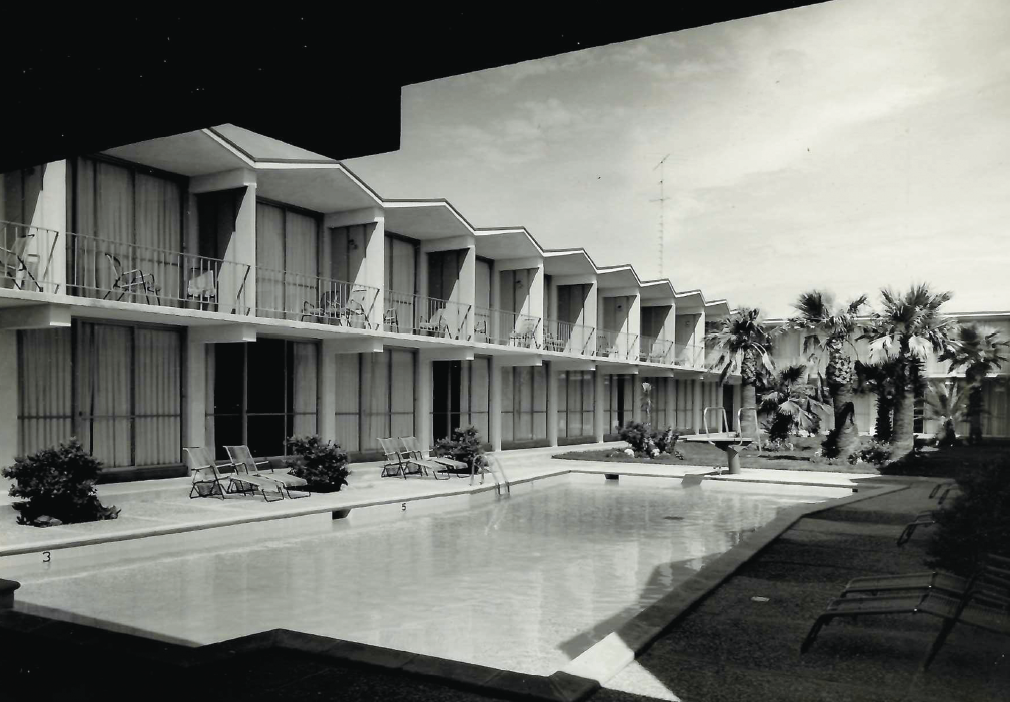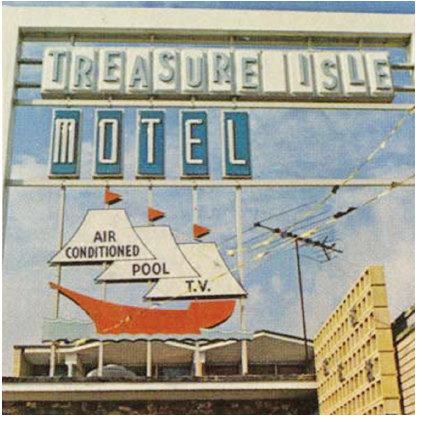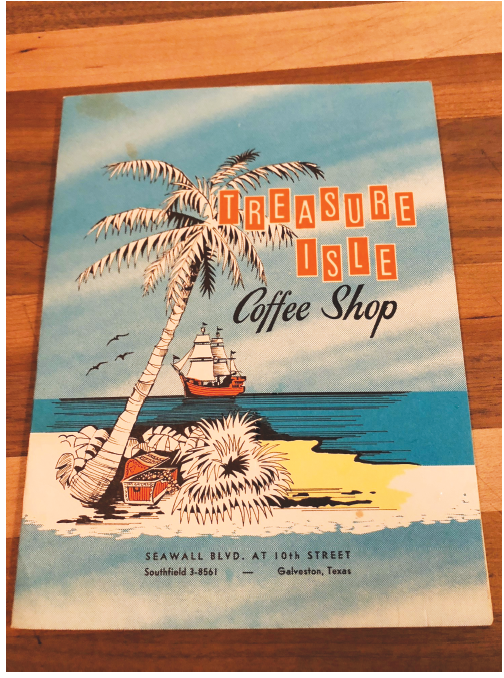When it was built on the Seawall in 1963, the Treasure Isle Motel was the definition of “swanky.” Designed by local architects Benjamin Joseph Kotin (1912-1993) and Tibor Eliahu Beerman (1925-2015), the motel across from Poretto Beach was one of the most popular and recognizable places to vacation, hold meetings, or enjoy a quick meal on the island.
The motel was owned by Kotin and his twin brother Soloman Kotin (1912-2001), who maintained offices for their architect’s business on site, as well. The brothers were born in Poland and moved with their family to Galveston in 1921.
Beerman, who partnered with the Kotins in an architectural firm in the 1950s and 1960s, was an immigrant from Czechoslovakia.
Treasure Isle Motel was not the Kotins’ first motel project in Galveston: The first was an ultra-modern transformation of the former King Courts at Seawall and 30th Street into the Knights Inn for a client in the late-1950s.
Plans for constructing Treasure Isle at Seawall and Tenth Street were first announced in 1955. The existing site had previously been the location of a motel that consisted of eight frame buildings with a total of 30 rooms. Those eight structures had been purchased by local veterinarian Dr. Edmond A. Henderson and moved to another location on east beach, where Henderson intended to operate them as tourist cabins.
Construction of Treasure Isle finally began on May 16, 1962. After delays that included weather challenges, the property was completed in 1963. The $350,000 motor hotel was constructed of storm-resistant reinforced concrete.

“There was the Galvez and the Seahorse, and then when ours was built it was a big deal for Galveston to have a new swanky motel,” said Karen Kotin Alkayam, the youngest of Ben’s three daughters.
The original blueprints of the motel show Kotin and Beerman’s exacting attention to detail. The low-slung, two-story profile, and the interior and exterior color scheme were exemplary examples of mid-century modern.
The building was a hollow quadrangle shape, in the center of which was a courtyard with tropical landscaping, and in which sat a 40,000-gallon, hourglass-shaped pool with a diving board. At the bottom of the pool was the image of a submerged treasure chest.
From the road, an iconic sign in the shape of a pirate ship in full sail—suspended by steel bars and topped with turquoise letters—appeared to float in front of the motel. It was easily recognizable by anyone who visited or lived on the island during the motel’s heyday.
Beneath the pirate ship sign was a carport with stone accent walls flanking the front door. Cedar plant boxes punctuated the bricks walls, always brimming with seasonal flowers.
Glazed turquoise and white cement cinderblock walls sheltered the outer breezeways, acting as a “solar block” from the harsh afternoon sun, while allowing the Gulf breezes to cool the areas.
As guests entered the lobby, they were greeted by a registration desk to the left and porthole style windows on the right wall, which offered a glimpse into the café. To the right, was the Treasure Isle 24-hour coffee shop managed by Dennis M. Cornell. An outdoor dining terrace overlooked the pool and courtyard.
Even visitors and locals who were not staying at the hotel often visited the café after a day at the beach to enjoy lunch, ice cream, or a chilled piece of pie from the refrigerated display case.
The motel’s meeting room, which was often the site of chamber of commerce and local club gatherings, accommodated up to 28 people. The kitchen and scullery were positioned behind the convention room. The site also featured a liquor, drug store, and curio shop for the convenience of guests.
Kotin and Beerman’s architectural business had an office, a drafting room, and a secretarial office behind the registration area on the left.
Cantilevered stairs led from the ground to second floor rooms, each with exterior doors.
 Air-conditioned guest rooms carried out the ultra-modern appeal of the motel, with sliding glass aluminum doors opening onto individual balconies facing the courtyard and pool.
Air-conditioned guest rooms carried out the ultra-modern appeal of the motel, with sliding glass aluminum doors opening onto individual balconies facing the courtyard and pool.
Inside, the rooms featured exposed concrete ceilings and walnut plywood wall panels in the main area, while bath areas were tiled in Tuscan pink or light blue hues. Each room had a color television and telephone.
Twelve of the 32 guest rooms were suites with their own kitchenettes, built-in bar, ice water supply, and automatic fresh coffee dispensers. The rate for a single room on opening day was $10, and $15 for a double room.
In February 1966, the hotel made news when then-Galveston Mayor Edward Schreiber went to the Treasure Isle Motel to greet Japanese visitors Dr. Shigeo Watanabe, his wife Shina, and the Watanbe’s son Shigeuki. The family had traveled to Galveston as representatives of Galveston’s sister city of Niigata, Japan, as part of the people-to-people diplomatic program.
In December 1966, Astronaut Walter M. Shirra Jr. and his wife were spotted having a quiet breakfast at 3 a.m. in the Treasure Isle Motel Coffee Shop after a Gemini Rendezvous Party held in Galveston.
Alkayam said she has many fond childhood memories of spending time at Treasure Isle.
 “I was the one who got to go work with my parents. My father’s office was inside the motel on the same level as the lobby. My mother (Faye Rosalie Schwartz, 1923-2018) had her own office there, as well, since she did a lot of the bookkeeping,” she said.
“I was the one who got to go work with my parents. My father’s office was inside the motel on the same level as the lobby. My mother (Faye Rosalie Schwartz, 1923-2018) had her own office there, as well, since she did a lot of the bookkeeping,” she said.
“I went with them in the mornings during summer sometimes and got to bring a friend to go swimming, then we would eat lunch in the coffee shop. It was a great childhood. The motel was full every summer with people from all over the south, and people would come back every year. It was the place to bring your family. It had full occupancy from Splash Day through Labor Day.”
Insurance paperwork for the motel reveals that Ben made a final addition to the property in 1970, spending $1,500. This would be his last work on the property before selling it and moving his family to Houston.
“We sold it to a local family, who, in turn, sold it to the owners who renamed it the Pearl Inn,” Alkayam said.
Jason and Kathy Lai of Galveston purchased the motel in February 1989. Immigrants from Taiwan, the couple already owned two Baskin Robbins stores on the island.
They renamed the property the Pearl Inn, and repainted it the distinctive yellow color that it remained until recently. The wood paneling in the rooms was removed, and, at some point, the hour glass-shaped pool was replaced with a rectangular pool.
“My father was very reserved and kind of quiet, and my uncle (Sol) was very outgoing and loved being around people, so they made a good team,” Alkayam said.
“My father put himself through college and made something grand for himself. As hard working and ambitious as my parents were, they were very family-oriented.”
Treasure Isle is now preparing for a new generation of visitors. Dave Jacoby, the motel’s new owner, is currently transforming the property into Hotel Lucine, and promises that the new hotel will be a stylish new island destination. Alkayam enthused that her family is “very excited” about the new owners plans for the motel.
Be sure to check out next month’s issue of Galveston Monthly for an exclusive look at the plans.